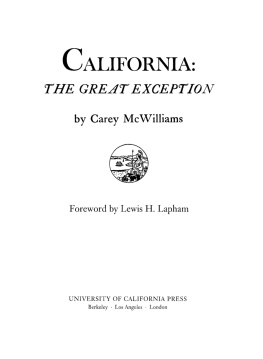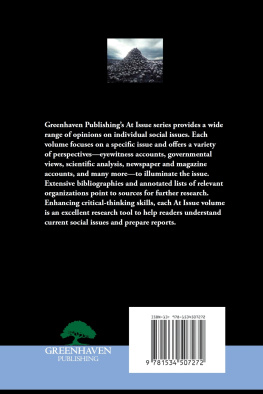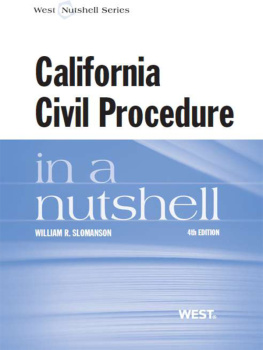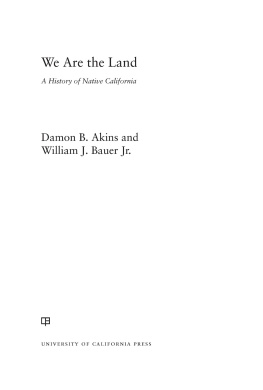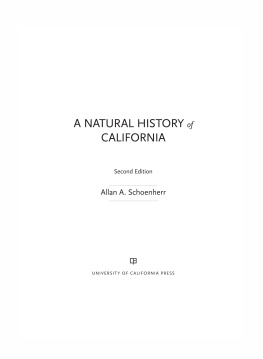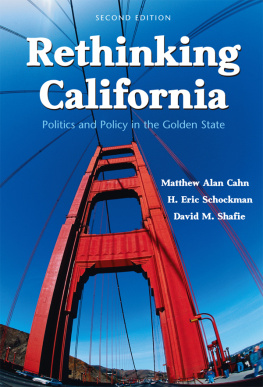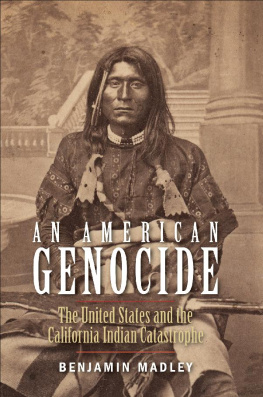
AN AMERICAN GENOCIDE
THE LAMAR SERIES IN WESTERN HISTORY
The Lamar Series in Western History includes scholarly books of general public interest that enhance the understanding of human affairs in the American West and contribute to a wider understanding of the Wests significance in the political, social, and cultural life of America. Comprising works of the highest quality, the series aims to increase the range and vitality of Western American history, focusing on frontier places and people, Indian and ethnic communities, the urban West and the environment, and the art and illustrated history of the American West.
Editorial Board
HOWARD R. LAMAR, Sterling Professor of History Emeritus,
Past President of Yale University
WILLIAM J. CRONON, University of WisconsinMadison
PHILIP J. DELORIA, University of Michigan
JOHN MACK FARAGHER, Yale University
JAY GITLIN, Yale University
GEORGE A. MILES, Beinecke Library, Yale University
MARTHA A. SANDWEISS, Princeton University
VIRGINIA J. SCHARFF, University of New Mexico
ROBERT M. UTLEY, Former Chief Historian, National Park Service
Recent Titles
Sovereignty for Survival: American Energy Development and
Indian Self-Determination, by James Robert Allison III
George I. Snchez: The Long Fight for Mexican American Integration,
by Carlos Kevin Blanton
The Yaquis and the Empire: Violence, Spanish Imperial Power, and Native
Resilience in Colonial Mexico, by Raphael Brewster Folsom
Gathering Together: The Shawnee People through Diaspora and
Nationhood, 16001870, by Sami Lakomki
An American Genocide: The United States and the California
Indian Catastrophe, 18461873, by Benjamin Madley
Natures Noblemen: Transatlantic Masculinities and the
Nineteenth-Century American West, by Monica Rico
Rush to Gold: The French and the California Gold Rush,
18481854, by Malcolm J. Rohrbough
Home Rule: Households, Manhood, and National Expansion on
the Eighteenth-Century Kentucky Frontier, by Honor Sachs
The Cherokee Diaspora: An Indigenous History of Migration,
Resettlement, and Identity, by Gregory D. Smithers
Sun Chief: The Autobiography of a Hopi Indian, by Don C. Talayesva,
edited by Leo W. Simmons, Second Edition
Before L.A.: Race, Space, and Municipal Power in Los Angeles,
17811894, by David Samuel Torres-Rouff
Wanted: The Outlaw Lives of Billy the Kid and Ned Kelly,
by Robert M. Utley
AN AMERICAN GENOCIDE

The United States and the California Indian Catastrophe, 18461873

Benjamin Madley

This book was made possible in part through the generosity of the UCLA History Department and the Division of Social Sciences and was published with assistance from the income of the Frederick John Kingsbury Memorial Fund.
Copyright 2016 by Benjamin Logan Madley.
All rights reserved.
This book may not be reproduced, in whole or in part, including illustrations, in any form (beyond that copying permitted by Sections 107 and 108 of the U.S. Copyright Law and except by reviewers for the public press), without written permission from the publishers.
Yale University Press books may be purchased in quantity for educational, business, or promotional use. For information, please e-mail (U.K. office).
Set in Electra type by Westchester Publishing Services.
Printed in the United States of America.
Library of Congress Control Number: 2015955528
ISBN 978-0-300-18136-4 (hardcover : alk. paper)
A catalogue record for this book is available from the British Library.
This paper meets the requirements of ANSI/NISO Z39.48-1992 (Permanence of Paper).
10 9 8 7 6 5 4 3 2 1
For California Indians, past, present, and future
White people want our land, want destroy us.... I hear people tell bout what Inyan do early days to white man. Nobody ever tell it what white man do to Inyan. Thats reason I tell it. Thats history. Thats truth.
Lucy Young (Lassik/Wailaki), 1939, eyewitness to genocide

CONTENTS

ACKNOWLEDGMENTS
At a place called Indian Ferry, not far from where my familys log cabin now stands, whites massacred at least thirty Shasta Indians in the spring of 1852. The victims had not attacked whites. Nor had they stolen from them. Whites killed them near the banks of the Klamath River merely because they were Indians. Few people have heard of this massacre or the many others like it. Yet there were scores of such atrocities. Hundreds of Indian-killing sites stain California from the fog-bound northwestern redwood coast to the searing southeastern deserts. Individuals, private groups, state militiamen, and US Army soldiers carried out these killings, ostensibly to protect non-Indians or to punish Indians for suspected crimes. In fact, the perpetrators often sought to annihilate Californias indigenous peoples between 1846 and 1873.
The story of the California Indian catastrophe is almost unrelentingly grim, which helps to explain why relatively little has been written about it, at least compared to other genocides. Until now, no one has written a comprehensive, year-by-year history of the cataclysm. It is, nevertheless, important history, for both California Indians and non-Indians. In researching and writing this book, I received guidance and support from many people and institutions.
Fellow scholars helped shape my ideas, methods, and writing. Gary Clayton Anderson, Ute Frevert, Albert Hurtado, Karl Jacoby, Adam Jones, Paul Kennedy, Howard Lamar, David Rich Lewis, Michael Magliari, Jeffrey Ostler, Russell Thornton, David Wrobel, and Natale Zappia provided crucial insights and direction. My fellow Yale graduate students Adam Arenson, Jens-Uwe Guettel, Gretchen Heefner, Michael Morgan, Aaron OConnell, Ashley Sousa, Henry Trotter, Owen Williams, and others provided valuable encouragement and advice. Edward Melillo, in particular, devoted his keen editorial eye to every page, and I am grateful for his sage advice. To my dissertation committee I owe unrepayable debts. George Miles helped me to map out a research strategy and provided copies of rare documents. John Demos shaped my writing and encouraged me to address major problems in US history. John Faragher guided me through theoretical and historical problems while suggesting sources and sharing insights into the workings of nineteenth-century California and the western United States. Finally, Ben Kiernan tirelessly read and reread drafts, spent many hours discussing genocide with me, and enthusiastically supported this project at every turn.
People from more than a dozen American Indian nations also informed my research, interpretations, and conclusions. Members of the Big Valley, Blue Lake, Elk Valley, Redding, and Smith River Rancherias, as well as the Round Valley and Yurok reservations, helped me to understand how genocide unfolded in northwestern California. Members of the Klamath Tribes of Oregon, the Modoc Tribe of Oklahoma, and Redding Rancheria provided insights into events in northeastern California. Finally, the Big Pine Paiute Tribe of the Owens Valley, the Bishop Paiute Tribe, as well as members of the Lone Pine Paiute-Shoshone and Fort Independence reservations, guided me in understanding genocide in eastern California. During visits to these communities, members listened carefully to my presentations, pointed out errors and omissions, provided documents and photographs, shared insights, and explained the importance of documenting killings, as well as the reasons that so few oral histories of these events remain. Community members also shared oral histories of massacres and killing campaigns that I used to locate written nineteenth-century sources describing these events. For example, Tom Ball, tribal officer Taylor David, Chief Bill Follis, tribal officer Jack Shadwick, and author Cheewa James spent hours discussing Modoc history with me. Redding Rancheria cultural resources manager James Hayward Sr. provided insights into Achumawi, Wintu, and Yana histories. Joseph Giovannetti provided Tolowa sources. William Bauer Jr. shared insights into Round Valley history and organized my visit there. To all of the American Indian people who guided this projectand whose names are too numerous to list hereI offer my deepest thanks. I am particularly grateful to Loren and Lena Bommelyn of Smith River Rancheria. For years they have acted as teachers, mentors, and friends while generously making important introductions. Finally, Amos Tripp kindly took the time to explain many of the legal issues associated with California Indian history, thus informing my emphasis on legal frameworks.
Next page

